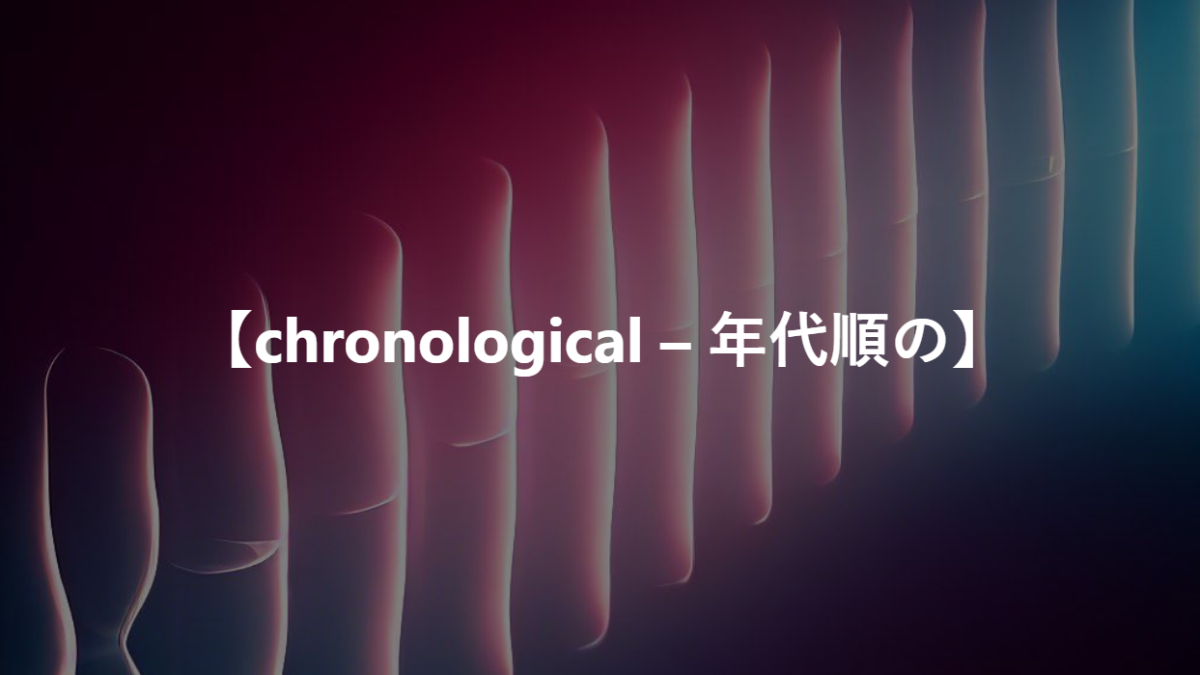語源・類義語・反対語・例文
【Chronological – 年代順の】という単語の語源とか由来を知っていますか?
“Chronological”は、ギリシャ語の「χρόνος」(chronos、時間)と「λόγος」(logos、言葉、理由)から派生しています。これら二つの語根を組み合わせた「χρονολογία」(chronologia)は、「時間の研究」または「時間の順序に関する記録」という意味になります。したがって、「chronological」は時間の経過に沿った順序、特に年代順や事象が起こった順に関連する事柄を指すようになりました。この単語は、歴史、文献、科学など、時間の流れを重視するさまざまな分野で用いられます。
“Chronological” derives from the Greek words “χρόνος” (chronos, meaning time) and “λόγος” (logos, meaning word or reason). Combining these two roots, “χρονολογία” (chronologia) translates to “the study of time” or “a record concerning the order of time.” Thus, “chronological” came to refer to anything related to the sequence of time, especially in the order of dates or events as they occurred. This term is used across various fields that emphasize the flow of time, such as history, literature, and science.
この単語の類義語・反対語を教えてください。
類義語
- Sequential – 順序的な
- Chronologic – 年代学的な(”Chronological”の別形)
- Temporal – 時間的な(時間の流れに関連するが、より広い意味合いを持つ)
- Ordered – 順序付けられた(一定の順序に従っていることを示す)
- Historical – 歴史的な(時間の流れに沿った出来事に焦点を当てた場合)
反対語
- Achronological – 非年代順の(時間の順序に従わない)
- Non-sequential – 非順序的な(特定の順序に従っていない)
- Random – 無作為の(順序や計画に基づかない)
- Unordered – 順不同の(順序がない、整理されていない)
- Simultaneous – 同時の(時間的に順序付けられていない、同時に起こる)
この単語に似た単語で間違いやすい単語はありますか?
- Chronologic:
- “Chronologic”は”Chronological”の別の形で、基本的に同じ意味を持ちます。しかし、一般的には”Chronological”の方がより頻繁に使用されます。
- Sequential:
- “Sequential”(順序的な)は、時間の流れに関連するかのように事象が一定の順序で発生することを指しますが、必ずしも時間に基づくわけではありません。例えば、手順やプロセスにおいて使われることがあります。
- Temporal:
- “Temporal”(時間的な)は時間に関連することを広く指しますが、”Chronological”ほど明確に時間の順序を示すわけではありません。”Temporal”は時間の概念や時間に関連する特性を一般的に述べる際に用いられます。
- Historical:
- “Historical”(歴史的な)は過去の出来事に関連することを指しますが、それらが特定の年代順に従っているとは限りません。”Chronological”とは異なり、”Historical”は歴史の事実や重要性に焦点を当てます。
この単語を使った例文を5つほど教えてください。
The events in the history book are presented in chronological order, allowing readers to follow the sequence of historical developments.
(その歴史書では、出来事が年代順に提示されており、読者は歴史の進展の順序に沿って辿ることができます。)
Please arrange the documents in chronological order, starting from the earliest date to the most recent.
(文書を年代順に並べてください。最も古い日付から最新の日付まで順序立ててください。)
The professor explained the theories in the lecture in a chronological manner, starting from the foundational concepts to the more advanced ideas.
(教授は講義で理論を年代順に説明しました。基礎的な概念からより高度なアイデアまでを順番に進めていきました。)
The exhibit showcases the artist’s works in chronological order, allowing visitors to see the evolution of their style over time.
(展示では、芸術家の作品が年代順に展示されており、訪れる人々は時間の経過に伴うスタイルの進化を見ることができます。)
The project timeline outlines the tasks and milestones in chronological order, providing a clear roadmap for project completion.
(プロジェクトのタイムラインは、タスクとマイルストーンを年代順に示し、プロジェクトの完了に向けた明確なロードマップを提供します。)
【chronological – 年代順の】のコロケーション
- Chronological order – 年代順の順序
- 出来事や記録が発生した時間の順に配列されています。この表現は、歴史的な出来事、文献の参照、または物語の展開を整理し提示する際によく用いられます。
- Chronological sequence – 年代順の連続
- 時間的な流れに従って一連の出来事が並べられることを意味します。これは、特定のテーマや主題に関連する出来事を時系列で追う場合に役立ちます。
- Chronological timeline – 年代順のタイムライン
- 重要な出来事を時間軸上に表示することで、特定の期間にわたる出来事の流れを視覚的に捉えることができます。教育やプレゼンテーションで利用され、情報の整理や理解を助けます。
- Chronological age – 年齢(生まれてからの経過年数)
- 個人が生まれてから現在までの経過年数を指します。この用語は、発達心理学や教育学など、年齢に関連する研究や議論で使用されます。
- Chronological narrative – 年代順の物語
- 物語や記述が出来事が実際に起こった順序で語られるスタイルを指します。読者や聞き手が情報やストーリーの流れを自然に追いやすくなります。
“Chronological”という単語は、時間の流れに沿った順序や出来事の配列を指す際に使われます。これに関連するコロケーションには、「年代順の順序」、「年代順の連続」、「年代順のタイムライン」、「年齢」、「年代順の物語」といった表現があります。これらのフレーズは、出来事や情報を時系列に整理し、提示することの重要性を強調します。
「年代順の順序」は、歴史的出来事や文献の参照、物語の展開などを、それが発生した時間に基づいて配列することを意味します。このアプローチにより、情報がより理解しやすく、追いやすくなります。
「年代順の連続」では、特定のテーマや主題に関連する出来事を時系列で追うことができ、出来事間の関連性や因果関係を明確にします。「年代順のタイムライン」を用いることで、重要な出来事を時間軸上に視覚的に表示し、特定の期間にわたる出来事の流れを一目で捉えることが可能になります。
また、「年齢」は、個人が生まれてから現在までの経過年数を示し、発達心理学や教育学での研究や議論に役立ちます。「年代順の物語」は、物語や記述が実際に起こった順序で語られるスタイルを指し、ストーリーの流れを自然に追いやすくします。
これらのコロケーションを通じて、「chronological」がどのようにして情報を整理し、因果関係を理解するのに役立つかが示されます。年代順に情報を配列することは、歴史、教育、物語、研究など様々な分野で情報の整理や理解を深めるための有効な手段となります。
The term “chronological” is used when referring to the order or arrangement of events following the flow of time. Related collocations include “chronological order,” “chronological sequence,” “chronological timeline,” “chronological age,” and “chronological narrative.” These phrases emphasize the importance of organizing and presenting events or information in a time-sequential manner.
“Chronological order” means arranging historical events, literature references, or story developments based on the time they occurred, making the information more understandable and easier to follow.
“Chronological sequence” allows for tracking events related to a specific theme or subject in the order they happened, clarifying the relationship and causality between events. Using a “chronological timeline,” significant events can be visually displayed on a timeline, capturing the flow of events over a specific period at a glance.
Furthermore, “chronological age” refers to the number of years that have passed since an individual was born, useful in studies and discussions in developmental psychology and education. “Chronological narrative” denotes a storytelling style where the narrative is told in the order events actually occurred, making the story’s progression natural to follow.
Through these collocations, it is demonstrated how “chronological” aids in organizing information and understanding causal relationships. Arranging information chronologically is an effective method for deepening the organization and comprehension of information across various fields such as history, education, storytelling, and research.
文法問題
- Choose the correct word to fill in the blank:
The historian presented the events in __ order to provide a clear timeline.
a) chronological
b) chronologically
c) chronology
d) chronologic
解答: a) chronological 解説: この文では「歴史家は明確なタイムラインを提供するために出来事を年代順に提示した」と言っています。ここでは「年代順の」という意味の形容詞が必要です。”chronological” は形容詞で「年代順の」という意味なので、正しい選択肢です。他の選択肢は文法的に正しくありません。”chronologically” は副詞、”chronology” は名詞、”chronologic” も形容詞ですが一般的ではありません。
- Identify the sentence that uses “chronological” correctly:
a) The events were arranged in a chronological list.
b) The book was written chronological to make it more interesting.
c) She explained the history chronological.
d) They presented the data in a chronological manner.
解答: a) The events were arranged in a chronological list. 解説: この文では「出来事が年代順のリストに整理されていた」と言っています。”chronological” は「年代順の」という意味で、ここでの使い方が正しいです。選択肢 b は “chronological” ではなく “chronologically”(副詞)が必要です。選択肢 c も “chronologically” が必要です。選択肢 d の “chronological manner” は文法的に正しいですが、一般的には “chronologically” の方が自然です。
- Choose the correct form of the word to complete the sentence:
The researcher organized the findings __ to highlight the progression over time.
a) chronological
b) chronologically
c) chronologic
d) chronology
解答: b) chronologically 解説: この文では「研究者は時間の進行を強調するために調査結果を年代順に整理した」と言っています。ここでは「年代順に」という意味の副詞が必要です。”chronologically” は副詞で「年代順に」という意味なので、正しい選択肢です。他の選択肢は文法的に正しくありません。”chronological” と “chronologic” は形容詞、”chronology” は名詞です。
- Select the sentence that best demonstrates the meaning of “chronological”:
a) The paintings were displayed in a random order, not chronological.
b) He listed the steps in chronological order to ensure clarity.
c) The report was written without any chronological consideration.
d) She spoke chronological about her experiences.
解答: b) He listed the steps in chronological order to ensure clarity.
解説: 選択肢 b) は「彼は明確にするために手順を年代順に並べた」という意味です。”chronological” は「年代順の」という意味の形容詞で、出来事や手順を起こった順に並べることを指します。この文では、「手順を年代順に並べる」ことで、明確に説明していることを示しており、”chronological” の意味を最もよく示しています。
他の選択肢の解説:
a) The paintings were displayed in a random order, not chronological.
この文では「絵画は年代順ではなく、ランダムな順序で展示された」と言っています。”chronological” が否定形で使われていますが、”chronological” の意味を示す例としては適していません。
c) The report was written without any chronological consideration.
この文では「その報告書は年代順の考慮なしに書かれた」と言っています。”chronological” が否定的に使われていますが、”chronological” の意味を示す例としては不十分です。
d) She spoke chronological about her experiences.
この文は文法的に間違っています。”chronological” は形容詞であり、この場合には副詞 “chronologically” を使うべきです。文法的に正しくないため、この選択肢は適していません。
5.Fill in the blank with the appropriate word:
The museum exhibit followed a __ sequence, showcasing the development of technology through the ages.
a) chronological
b) chronologically
c) chronology
d) chronologic
解答: a) chronological 解説: この文では「博物館の展示は年代順のシーケンスに従っており、時代を通じた技術の発展を展示している」と言っています。ここでは「年代順の」という意味の形容詞が必要です。”chronological” は形容詞で「年代順の」という意味なので、正しい選択肢です。他の選択肢は文法的に正しくありません。”chronologically” は副詞、”chronology” は名詞、”chronologic” も形容詞ですが一般的ではありません。

